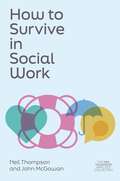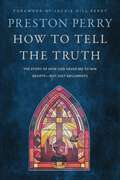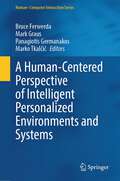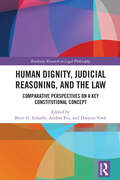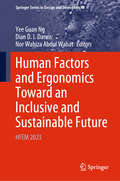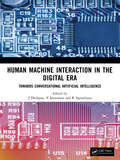- Table View
- List View
How to Survive in Social Work (The Neil Thompson Practice Collection)
by Neil Thompson John McGowanSocial worker. You're a helping hand, a rock in the tempest, a friendly face through the hard times, and a catalyst for change. But what about you? How do you keep going when the pressure just keeps rising?In this no-nonsense handbook, Neil Thompson and John McGowan distil years of social work expertise into key strategies to overcome the challenges that come with the profession. Each chapter is full of clear, practical advice on staying resilient in the face of tough situations, whether they're political, social, or economic. Handy frameworks and expert advice will strengthen your practice and give you a solid structure to build on, helping you fulfil your potential as a social worker and provide better support for your clients. Social work is tough, but with the guidance and support in this book you can learn to tackle the challenges and thrive as a force for change.
How to Teach Literature - and Still Love Reading
by Heather Holmes Lisa AngusIf you're a book lover with a To Be Read list as long as your arm, and you also happen to be a teacher of English literature, How to Teach Literature - and Still Love Reading is the book for you.Written by two experienced teachers and English literature examiners, this book is packed full of inspirational and original reading suggestions from poetry through to drama and prose, together with practical strategies to integrate your reading into the classroom.Aimed at key stage 3 and KS4 teachers, this book will not only help you navigate the perils of external examinations but will also reignite your creativity in the classroom. It will revitalise your teaching and lead to engaging English literature lessons your students will enjoy.As for that TBR list - it's only going to get longer!
How to Tell the Truth: The Story of How God Saved me to Win Hearts, Not Just Arguments
by Preston Perry'Preston fuels our courage, revisits the essentials, and lights a path back to the narrow road.'- CHARLIE DATES'Preston shares his compelling story of becoming a Christian and then provides a road map - through his successes and failures - for how to lovingly and naturally share your faith with others.'- SEAN McDOWELLIn How to Tell the Truth, Preston Perry tells the story of how God chased him. The streets of Chicago were his home, but amid crime and violence God found him and awakened in him a gift for sharing his faith.On those Chicago streets he encountered all sorts of people who had their own versions of the truth - from Jehovah's Witnesses to Mormons to Hebrew Israelites. That is where Preston discovered not only the importance of the truth but also how to tell the truth in a way that speaks to someone's heart. Sharing our faith is not about winning arguments; it's about winning hearts. And the way we do that is by engaging with friends, neighbours, and co-workers with truth, dignity, and respect.Set against the powerful testimony of how God stepped into rescue Preston from his early life of crime and drugs, How to Tell the Truth is a hope-filled encouragement to take up Jesus' invitation to 'make disciples of all nations' and enjoy the powerful conversations that result. Unlike any other book on evangelism, How to Tell the Truth will demonstrate how to share your faith with confidence and compassion. Perfect for anyone who loves to talk about Jesus or wishes they could do it better.
How to Think and Intervene Like a Single-Session Therapist
by Windy DrydenTherapists new to Single-Session Therapy (SST) will often struggle to bring the SST mindset to the work and will in turn struggle to help their clients get the most out of the time that they choose to spend together.How to Think and Intervene Like a Single-Session Therapist provides the trainee with an opportunity to discover how experienced therapists think, and how their thoughts influence their interventions within the single-session context. Presenting SST in a way that both interests conventional therapists and shows the potential of this way of delivering therapy services, Windy Dryden details the multiple levels of thinking and intervening that go into single-session practice. He covers the orientation thinking experienced SST therapists have about the work when they are not doing it, the pre-session thinking they engage in while actively preparing to do the work, and the in-session thinking they engage in while doing the work. The book outlines the theory behind SST and the ways those ideas form its practice, using clinical vignettes and case scenarios to demonstrate how single-session therapists can make the best use of the limited time with their clients. The book additionally presents an ongoing dialogue between an SST therapist and a conventional therapist to highlight the thinking of the former and how the criticisms of SST by the latter can be responded to.This highly practical guide will be essential reading for any therapist who is new to or has recently been introduced to the practice of SST.
How to Think and Intervene Like a Single-Session Therapist
by Windy DrydenTherapists new to Single-Session Therapy (SST) will often struggle to bring the SST mindset to the work and will in turn struggle to help their clients get the most out of the time that they choose to spend together.How to Think and Intervene Like a Single-Session Therapist provides the trainee with an opportunity to discover how experienced therapists think, and how their thoughts influence their interventions within the single-session context. Presenting SST in a way that both interests conventional therapists and shows the potential of this way of delivering therapy services, Windy Dryden details the multiple levels of thinking and intervening that go into single-session practice. He covers the orientation thinking experienced SST therapists have about the work when they are not doing it, the pre-session thinking they engage in while actively preparing to do the work, and the in-session thinking they engage in while doing the work. The book outlines the theory behind SST and the ways those ideas form its practice, using clinical vignettes and case scenarios to demonstrate how single-session therapists can make the best use of the limited time with their clients. The book additionally presents an ongoing dialogue between an SST therapist and a conventional therapist to highlight the thinking of the former and how the criticisms of SST by the latter can be responded to.This highly practical guide will be essential reading for any therapist who is new to or has recently been introduced to the practice of SST.
How to Think and Intervene Like an REBT Therapist
by Windy DrydenTrainee therapists often stick rigidly to the therapeutic guidelines that are taught to them on their training course, or adopted from a book, regardless of their approach. How to Think and Intervene Like an REBT Therapist provides the trainee with an opportunity to discover how experienced therapists think, and how their thoughts influence their interventions when using Rational Emotive Behaviour Therapy (REBT).In this book, Windy Dryden compares the thinking and intervening characteristics of experienced REBT therapists with the actions of trainees making errors typical of people at an introductory level. By using clinical vignettes, case scenarios and verbatim dialogue, he demonstrates how REBT therapists can make better use of the working alliance between themselves, their clients and their trainees, and use REBT more flexibly in practice. This new edition is updated with modern language and examples to make it more user friendly and accessible for readers. New references and the citing of developments in theory bring the book up to date with advancements in the field and create greater flexibility for both therapist and client.This highly practical guide remains essential reading for all those who have recently been introduced to REBT.
How to Think and Intervene Like an REBT Therapist
by Windy DrydenTrainee therapists often stick rigidly to the therapeutic guidelines that are taught to them on their training course, or adopted from a book, regardless of their approach. How to Think and Intervene Like an REBT Therapist provides the trainee with an opportunity to discover how experienced therapists think, and how their thoughts influence their interventions when using Rational Emotive Behaviour Therapy (REBT).In this book, Windy Dryden compares the thinking and intervening characteristics of experienced REBT therapists with the actions of trainees making errors typical of people at an introductory level. By using clinical vignettes, case scenarios and verbatim dialogue, he demonstrates how REBT therapists can make better use of the working alliance between themselves, their clients and their trainees, and use REBT more flexibly in practice. This new edition is updated with modern language and examples to make it more user friendly and accessible for readers. New references and the citing of developments in theory bring the book up to date with advancements in the field and create greater flexibility for both therapist and client.This highly practical guide remains essential reading for all those who have recently been introduced to REBT.
How to Use Customer Data: Navigating GDPR, DPDI and a Future with Marketing AI
by Sachiko ScheuingData-driven marketing is a huge aspect of any modern-day marketing plan, but balancing customers' privacy concerns with the latest innovations can be a complex challenge. When done right, data-driven marketing can build customer trust for sustainable long-term value. This is precisely where How to Use Customer Data comes in, by breaking down everything you need to know about this fast-moving field into one simple and easy to read guide.Designed specifically for marketing professionals, this guide explains the principles of data protection, explores the legal requirements of the GDPR and UK DPDI Bill/Act and provides clarity on exactly what you need to know and do to be compliant whilst also looking at how using data well can improve the customer journey through personalization. Tackling all the hot issues of the moment, this book looks at how digitally mature marketers can work in compliance, how to use clean rooms and pseudonymization to promote trust and the impact AI could have, making it a must-read for all marketing professionals.
How to Win a Grand Prix: From Pit Lane to Podium - the Inside Track
by Bernie Collins'Bernie is not only a great strategist, but also a great team player and competitor' Sebastian VettelRace-winning team strategist shows how F1 really works. Welcome to Bernie Collins' world. Formula 1 drivers are the public face of Grand Prix racing but behind every driver is a team of several hundred people sharing the same passionate desire to win. On race day it's the Team Strategist who calls the shots, working under immense pressure to make split second and crucial decisions. Through her eyes and experience as a Performance Engineer and Head of Race Strategy, Bernie takes you behind the scenes of a Formula 1 team - both in the factory and at the races - to uncover what it takes to put two Formula 1 cars on the grid and go racing.How to Win a Grand Prix gives incredible insight of the entire process from design and construction, through pre-season testing, and how a team prepares for each Grand Prix. For race weekend itself, Bernie recreates it hour-by-hour to plunge the reader behind the pit wall and see what it's actually like to get from grid to podium.
How Values Education Can Improve Student and Teacher Wellbeing: A Simple Guide to the ‘Education in Human Values’ Approach
by Margaret Taplin Roger Packham Kevin FrancisPresenting Values Education as a solution to major challenges in education such as student disengagement and teacher burnout, this book provides a wealth of practical advice about how to implement the Education in Human Values approach in schools, promoting wellness and improved educational outcomes.Values Education is a world-wide movement and comes in several forms. This book explains the need for and nature of values education, provides practical, easy strategies for implementing the Education in Human Values (EHV) approach, and outlines the educational theories that underpin it. The practical strategies in this book can be implemented in small increments in all aspects of school life. The focus is on both student and teacher wellbeing. The methods can also be used by teachers to address their own professional and personal challenges and to help them cope with difficult situations that cannot be changed.Written for teachers, teacher educators, and teachers in training, this book is the one-stop-shop for gaining a better understanding of values education, how it can support whole-school wellbeing and how to implement it effectively.
How Values Education Can Improve Student and Teacher Wellbeing: A Simple Guide to the ‘Education in Human Values’ Approach
by Margaret Taplin Roger Packham Kevin FrancisPresenting Values Education as a solution to major challenges in education such as student disengagement and teacher burnout, this book provides a wealth of practical advice about how to implement the Education in Human Values approach in schools, promoting wellness and improved educational outcomes.Values Education is a world-wide movement and comes in several forms. This book explains the need for and nature of values education, provides practical, easy strategies for implementing the Education in Human Values (EHV) approach, and outlines the educational theories that underpin it. The practical strategies in this book can be implemented in small increments in all aspects of school life. The focus is on both student and teacher wellbeing. The methods can also be used by teachers to address their own professional and personal challenges and to help them cope with difficult situations that cannot be changed.Written for teachers, teacher educators, and teachers in training, this book is the one-stop-shop for gaining a better understanding of values education, how it can support whole-school wellbeing and how to implement it effectively.
How Was It for You?: Stories from a Sex Worker
by Eve SmithThe author of this book is a sex worker.Let’s call her Eve.Eve is someone’s partner. Someone’s mother.'It is heartening to find humour and a glimmer of hope' - Jo Brand'Unflinching . . . Everyone should read this book' - Emily Edwards, author of The HerdThe author of How Was It for You? has worked across the sex industry for twenty years: in a brothel, as an escort, in a strip club, online and as a dominatrix. In this candid memoir she reveals all: the good stuff, the bad, and the downright ugly.We lie with her poolside as she visits wealthy clients at their Caribbean villas. We watch from the public gallery as she is dragged in and out of court by the law. We perch at her side in a cell as she contemplates the true meaning of freedom. And we’re with her as she discovers she's pregnant and her body is given another job to do: growing and giving birth to a baby.Honest, eye-opening, full of fury and frequently funny, How Was It for You? will give you a unique insight into what’s happening in society’s shadows. It is an unforgettable walk in someone else’s high heels.Eve Smith is a pseudonym. Any links to persons living or dead is coincidental.
Human-Animal Interactions in Zoos: Integrating Science and Practice
by Terry L. Maple Courtney Collins Amanda D. Webber Ellen Williams Geoff Hosey Vicky Melfi Sarah Webber Samantha J. Chiew Jon Coe Neil D’Cruze Angela J Dean Polly Doodson Lucy Dumbell Ashley N. Edes Kelly S Fielding Georgina Groves Lauren M. Hemsworth Paul H. Hemsworth Julia Hoy Violet Hunton Mark J. Learmonth Emily M McLeod Georgia Oaten Chris Pawson Bonnie M. Perdue David M. Powell Samantha WardHuman-Animal Interactions (HAI) are a primary welfare interest to both animal scientists and practitioners. In zoos and aquariums, the study of Animal-Visitor Interactions (AVI), including both the impact of visitors on animals (the visitor effect) and the impact of animals on visitors (the visitor experience), have become a focus for understanding HAIs in zoos. The study of HAIs in zoos has grown to consider a number of factors, including animal-staff interactions and bonds, modern exhibit design and technology, direct and indirect interactions, as well as positive and negative impacts on both animals and visitor alike. This thought-provoking book summarizes the latest research concerning the impacts of HAIs in zoos, including considerations for conducting research and managing HAIs. The book: Explores the interactions of animals with keepers, veterinary professionals, and other staff, and the effects of those interactions on the welfare of animals. Considers the impact of visitors on the well-being of animals. Covers the effects of interactions on education and the visitor experience. Outlines the use of technology to enhance experience, and improve animal welfare. Details theoretical, ethical, and practical considerations relevant to HAIs in zoos. An invaluable resource for animal behaviour and welfare scientists, students and practitioners, as well as anyone working with zoo animals.
Human Barrier Design and Lifecycle: A Cognitive Ergonomics Approach and Path Forward
by Tom ShephardA common source of failure in a human‑dependent barrier or safety critical task is a designed‑in mismatch error. The mismatch is a cognitive demand that exceeds the human capability to reliably and promptly respond to that demand given the plausible situations at that moment. Demand situations often include incomplete information, increased time pressures, and challenging environments. This book presents innovative solutions to reveal, prevent, and mitigate these and many other cognitive‑type errors in barriers and safety critical tasks. The comprehensive model and methodologies also provide insight into where and to what extent these barriers and task types may be significantly underspecified and the potential consequences.This title presents a new and comprehensive prototype design and lifecycle model specific to human‑dependent barriers and safety critical tasks. Designed to supplement current practice, the model is fully underpinned by cognitive ergonomics and cognitive science. The book also presents a compelling case for why a new global consensus standard specific to human‑dependent barriers is needed. Taking a novel approach, it presents its suggested basis, framing, and content. Both solutions seek to redress deficiencies in global regulations, standards, and practice. The model is guided by industry recommendations and best practice guidance and solutions from globally recognized experts. Its processes are fully explained and supported by examples, analysis, and well‑researched background materials. Real‑life case studies from offshore oil and gas, chemical manufacturing, transmission pipelines, and product storage provide further insight into how overt and latent design errors contributed to barrier degradation and failure and the consequence of those errors.An essential and fascinating read for professionals, Human Barrier Design and Lifecycle: A Cognitive Ergonomics Approach and Path Forward will appeal to those in the fields of human factors, process and technical safety, functional safety, display and safety system design, risk management, facility engineering, and facility operations and maintenance.Chapters 1 and 8 of this book are freely available as downloadable Open Access PDFs at http://www.taylorfrancis.com under a Creative Commons Attribution-Non Commercial-No Derivatives (CC-BYNC-ND) 4.0 International license.
Human-Centered Design, Operation and Evaluation of Mobile Communications: 5th International Conference, MOBILE 2024, Held as Part of the 26th HCI International Conference, HCII 2024, Washington, DC, USA, June 29–July 4, 2024, Proceedings, Part I (Lecture Notes in Computer Science #14737)
by June Wei George MargetisThis book constitutes the refereed proceedings of the 5th International Conference on Design, Operation and Evaluation of Mobile Communications, MOBILE 2024, held as part of the 26th International Conference, HCI International 2024, which was held in Washington, DC, USA, during June 29-July 4, 2024. The total of 1271 papers and 309 posters included in the HCII 2024 proceedings was carefully reviewed and selected from 5108 submissions. The MOBILE 2024 proceedings were organized in the following topical sections: Part I: Mobile health and wellbeing; mobile applications, serious games and advanced interfaces; Part II: Mobile commerce, marketing and retail; mobile security, privacy, and safety; mobile user experience and design.
Human-Centered Design, Operation and Evaluation of Mobile Communications: 5th International Conference, MOBILE 2024, Held as Part of the 26th HCI International Conference, HCII 2024, Washington, DC, USA, June 29–July 4, 2024, Proceedings, Part II (Lecture Notes in Computer Science #14738)
by June Wei George MargetisThis book constitutes the refereed proceedings of the 5th International Conference on Design, Operation and Evaluation of Mobile Communications, MOBILE 2024, held as part of the 26th International Conference, HCI International 2024, which was held in Washington, DC, USA, during June 29-July 4, 2024. The total of 1271 papers and 309 posters included in the HCII 2024 proceedings was carefully reviewed and selected from 5108 submissions. The MOBILE 2024 proceedings were organized in the following topical sections: Part I: Mobile health and wellbeing; mobile applications, serious games and advanced interfaces; Part II: Mobile commerce, marketing and retail; mobile security, privacy, and safety; mobile user experience and design.
A Human-Centered Perspective of Intelligent Personalized Environments and Systems (Human–Computer Interaction Series)
by Marko Tkalčič Panagiotis Germanakos Bruce Ferwerda Mark GrausThis book investigates the potential of combining the more quantitative - data-driven techniques with the more qualitative - theory-driven approaches towards the design of user-centred intelligent systems. It seeks to explore the potential of incorporating factors grounded in psychological theory into adaptive/intelligent routines, mechanisms, technologies and innovations. It highlights models, methods and tools that are emerging from their convergence along with challenges and lessons learned. Special emphasis is placed on promoting original insights and paradigms with respect to latest technologies, current research trends, and innovation directions, e.g., incorporating variables derived from psychological theory and individual differences in adaptive intelligent systems so as to increase explainability, fairness, and transparency, and decrease bias during interactions while the control remains with the user.
Human-Centred Economics: The Living Standards of Nations
by Richard SamansThis open access book examines the chronic underperformance of economies with respect to inclusion, sustainability and resilience. It finds that the standard liberal economic growth and development model has evolved over the past century in a fundamentally unbalanced manner that underemphasizes the crucial role of institutions – legal norms, policy incentives and public administrative capacities – in translating market-based growth in the production of goods and services into broad and sustainable gains in social welfare at the household level. Correcting this imbalance of emphasis in economic theory and policy between markets and institutions, production and distribution, and national income and household living standards is the single most important step required to transcend 20th century trickle-down “neoliberalism” and replace it with a more human-centred model of economic progress in the 21st century. The book breaks new ground by integrating the principal institutional dimensions of the social contract into the heart of macroeconomic theory and presenting extensive corresponding reforms of domestic and international economic policy to refocus them on the median living standards, rather than primarily aggregate wealth or GDP, of nations. This is the bottom-line measure of national economic performance, and it depends on the strength of both markets of exchange and institutions in such areas as labour and social protection, financial and corporate governance, competition and rents, anti-corruption, infrastructure and basic necessities, environmental protection, education and skilling, etc. Extensive comparative data are presented demonstrating that countries at every level of economic development have ample policy space to narrow their “welfare gaps” – their underperformance on these and other key aspects of household living standards relative to the frontier of leading policy practice in peer countries.
Human-Centric Decision and Negotiation Support for Societal Transitions: 24th International Conference on Group Decision and Negotiation, GDN 2024, Porto, Portugal, June 3–5, 2024, Proceedings (Lecture Notes in Business Information Processing #509)
by Pascale Zaraté Yu Maemura Marta Campos Ferreira Thomasz WachowiczThis book constitutes the refereed proceedings of the 24th International Conference on Group Decision and Negotiation, GDN 2024, which took place in Porto, Portugal, during June 2–5, 2024. The field of Group Decision and Negotiation focuses on decision processes with at least two participants and a common goal but conflicting individual goals. Research areas of Group Decision and Negotiation include electronic negotiations, experiments, the role of emotions in group decision and negotiations, preference elicitation and decision support for group decisions and negotiations, and conflict resolution principles. The 13 full papers presented in this volume were carefully reviewed and selected from 100 submissions. They were organized in the following topical sections: Conflict Resolution; Preference Modeling for Group Decision and Negotiation; Collaborative and Responsible Negotiation Support Systems and Studies.
Human Digital Twin: Exploring Connectivity and Security Issues (SpringerBriefs in Computer Science)
by Changyan Yi Jun Cai Samuel D. OkegbileHuman digital twin (HDT) is a transformative technology poised to transform various human-centric systems. With its potential applications in personalized healthcare, HDT promises swift, precise, and efficient healthcare services through the integration of cutting-edge technologies such as artificial intelligence, data analytics, internet of things, cybersecurity as well as virtual and augmented reality. This book addresses the critical gap in the existing literature by offering a comprehensive exploration of connectivity solutions for HDT while prioritizing reliability, security, and privacy. Key topics covered include the foundational concept of HDT, its design requirements and associated challenges, edge-assisted human-to-virtual solutions, blockchain-enabled data-sharing mechanisms, and differentially private federated multi-task learning (DPFML) methodologies tailored for HDT.The discussion on the concept of HDT encompasses an overview of its applications and its specific characteristics when compared to the conventional digital twin models. In addressing the design requirements and challenges of HDT, the text delves into the complexities of securing high-quality data, ensuring ultra-reliable and low-latency communication, data privacy and integrity, while managing storage, computation and analytics. Exploring edge-assisted human-to-virtual solutions, the book also introduces a connectivity framework and details the modeling process for human-to-virtual twin connectivity. The book later presents an in-depth examination of the practical Byzantine fault tolerance framework, followed by a discussion on shard-based Byzantine fault-tolerant schemes tailored for HDT, along with analyses of latency and throughput.Furthermore, the book outlines the framework for DPFML-assisted human-to-virtual twin connectivity, accompanied by a novel consensus algorithm known as the proof of model quality. Finally, it presents future research directions aimed at addressing communication challenges hindering the seamless design and development of HDT. By offering this comprehensive exploration, the book serves as a valuable resource for researchers, practitioners, and policymakers seeking to navigate the evolving landscape of HDT and its transformative potential in various domains.
Human Dignity, Judicial Reasoning, and the Law: Comparative Perspectives on a Key Constitutional Concept (Routledge Research in Legal Philosophy)
by Andrea Pin Brett G. Scharffs Dmytro VovkThis volume explores how national and international human rights courts interpret and apply human dignity. The book tracks the increasing deployment of the concept of human dignity within national and international courts in recent decades. It identifies how human-dignity-based arguments have expanded to cover larger sets of cases: from the right to life or to integrity or anti-discrimination, the concept has surfaced in disputes about political and social rights and rule of law requirements, such as equality or legal certainty. The core message of the book is that judges understand, interpret, and apply human dignity differently. An inflation in the judicial recourse to human dignity can saturate the legal environment, depriving the concepts as well as human-rights-based narratives of salience, and threaten the predictability of court decisions. The book will appeal to philosophers of law, constitutional theorists and lawyers, legal comparativists, and internal law specialists. Whilst being dedicated specifically to human dignity jurisprudence, the book touches on many aspects of judiciary and as such will also be of interest to researchers studying legal reasoning, interpretation and application of the law and courts, as well as social philosophers, political scientists, and sociologists of law, politics, and religion.
Human Dignity, Judicial Reasoning, and the Law: Comparative Perspectives on a Key Constitutional Concept (Routledge Research in Legal Philosophy)
This volume explores how national and international human rights courts interpret and apply human dignity. The book tracks the increasing deployment of the concept of human dignity within national and international courts in recent decades. It identifies how human-dignity-based arguments have expanded to cover larger sets of cases: from the right to life or to integrity or anti-discrimination, the concept has surfaced in disputes about political and social rights and rule of law requirements, such as equality or legal certainty. The core message of the book is that judges understand, interpret, and apply human dignity differently. An inflation in the judicial recourse to human dignity can saturate the legal environment, depriving the concepts as well as human-rights-based narratives of salience, and threaten the predictability of court decisions. The book will appeal to philosophers of law, constitutional theorists and lawyers, legal comparativists, and internal law specialists. Whilst being dedicated specifically to human dignity jurisprudence, the book touches on many aspects of judiciary and as such will also be of interest to researchers studying legal reasoning, interpretation and application of the law and courts, as well as social philosophers, political scientists, and sociologists of law, politics, and religion.
Human Factors and Ergonomics Toward an Inclusive and Sustainable Future: HFEM 2023 (Springer Series in Design and Innovation #46)
by Yee Guan Ng Dian D. I. Daruis Nor Wahiza Abdul WahatThis book gathers the refereed proceedings of the 5th HFEM Biennial Conference on Human Factors and Ergonomics, organized by the Human Factors and Ergonomics Society Malaysia, held in Langkawi, Malaysia on August 13–18, 2023. Under the theme "Accelerating Human Factors and Ergonomics Toward an Inclusive and Sustainable Future", it highlights the latest theories and models, as well as cutting-edge technologies and applications on human factors and ergonomics. By combining findings from a range of disciplines including engineering, design, robotics, health care, management, computer science, human biology, and behavioral science, it offers an excellent source of innovative ideas to stimulate future discussions and developments aimed at applying knowledge and techniques to optimize system performance, while at the same time promoting the health, safety, and well-being of individuals. It includes papers from researchers and practitioners, scientists and physicians, institutional leaders, managers, and policy makers that contribute to constructing the human factors and ergonomics approach across a variety of methodologies, domains, and productive sectors.
Human Flourishing, Spiritual Awakening and Cultural Renewal: Personal and Communal Challenges
by Francisco Díaz Estrada Catalina Elena Dobre Rafael García PavónThis book seeks to generate a theoretical and a reflective framework to re-connect people with culture and spirituality. It seeks to recreate important links between these domains to provide interpretative, foundational, and ethical perspectives. It is distinctive in that it focusses on the challenges that humanity is facing at a cultural, social, moral, and spiritual level. It provides a philosophical understanding of humanity from a humanistic and multidisciplinary perspective (encompassing ethics, language, art/cinema, political, cultural and gender approaches) and offers a variety of ways of how we can rethink our culture and our society for the future.
Human Machine Interaction in the Digital Era: Towards Conversational Artificial Intelligence
by J. Dhilipan V. Saravanan R. AgusthiyarThe Human Machine Interaction in the Digital Era (ICHMIDE) 2023 conference aims to address the main issues of concern in the design issues with a particular emphasis on the design and development of interfaces for autonomous robots. Its main objective is to provide an international forum for the dissemination and exchange of up-to-date scientific information on research related to integrated human/machine systems at multiple scales, and includes areas such as human/machine interaction, engineering mathematical models, assistive technologies, system modelling, design, testing and validation. The organization of ICHMS is based on the following Track types: Smart Applications for Digital Era, Computational Mathematical and Electronics, Intelligent Systems in Security and Communication Technologies, Technological Interventions using AI and Machine Learning, Applied Science, and IoT Techniques for Industries.
